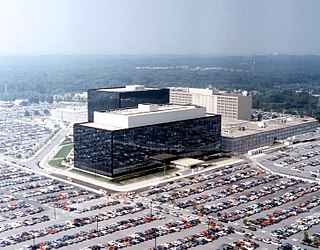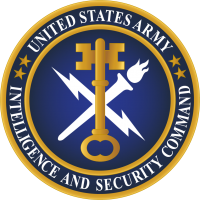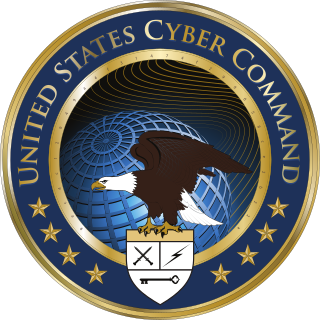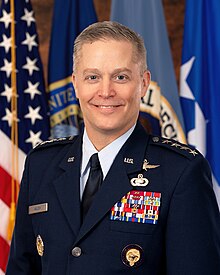
Fort George G. Meade is a United States Army installation located in Maryland, that includes the Defense Information School, the Defense Media Activity, the United States Army Field Band, and the headquarters of United States Cyber Command, the National Security Agency, the Defense Courier Service, Defense Information Systems Agency headquarters, and the U.S. Navy's Cryptologic Warfare Group Six. It is named for George G. Meade, a Union general from the U.S. Civil War, who served as commander of the Army of the Potomac. The fort's smaller census-designated place includes support facilities such as schools, housing, and the offices of the Military Intelligence Civilian Excepted Career Program (MICECP).

The Joint Chiefs of Staff (JCS) is the body of the most senior uniformed leaders within the United States Department of Defense, which advises the president of the United States, the secretary of defense, the Homeland Security Council and the National Security Council on military matters. The composition of the Joint Chiefs of Staff is defined by statute and consists of a chairman (CJCS), a vice chairman (VJCS), the chiefs of the Army, Marine Corps, Navy, Air Force, Space Force, and the chief of the National Guard Bureau. Each of the individual service chiefs, outside their JCS obligations, works directly under the secretaries of their respective military departments, e.g. the secretary of the Army, the secretary of the Navy, and the secretary of the Air Force.

The chairman of the Joint Chiefs of Staff (CJCS) is the presiding officer of the Joint Chiefs of Staff (JCS). The chairman is the highest-ranking and most senior military officer in the United States Armed Forces and the principal military advisor to the president, the National Security Council, the Homeland Security Council, and the secretary of defense. While the chairman of the Joint Chiefs of Staff outranks all other commissioned officers, the chairman is prohibited by law from having operational command authority over the armed forces; however, the chairman assists the president and the secretary of defense in exercising their command functions.

The Central Security Service (CSS) is a combat support agency of the United States Department of Defense which was established in 1972 to integrate the National Security Agency (NSA) and the Service Cryptologic Components (SCC) of the United States Armed Forces in the field of signals intelligence, cryptology, and information assurance at the tactical level. In 2002, the CSS had approximately 25,000 uniformed members. It is part of the United States Intelligence Community.

The United States Naval Criminal Investigative Service (NCIS) is the primary investigative law enforcement agency of the U.S. Department of the Navy. Its primary function is to investigate major criminal activities involving the Navy and Marine Corps, though its broad mandate includes national security, counterintelligence, counterterrorism, cyberwarfare, and the protection of U.S. naval assets worldwide. NCIS is the successor organization to the former Naval Investigative Service (NIS), which was established by the Office of Naval Intelligence after the Second World War.
A unified combatant command, also referred to as a combatant command (CCMD), is a joint military command of the United States Department of Defense that is composed of units from two or more service branches of the United States Armed Forces, and conducts broad and continuing missions. There are currently 11 unified combatant commands, and each is established as the highest echelon of military commands, in order to provide effective command and control of all U.S. military forces, regardless of branch of service, during peace or during war time. Unified combatant commands are organized either on a geographical basis or on a functional basis, e.g., special operations, force projection, transport, and cybersecurity. Currently, seven combatant commands are designated as geographical, and four are designated as functional. Unified combatant commands are "joint" commands and have specific badges denoting their affiliation.

Keith Brian Alexander is a retired four-star general of the United States Army, who served as director of the National Security Agency, chief of the Central Security Service, and commander of the United States Cyber Command. He previously served as Deputy Chief of Staff, G-2 (Intelligence), United States Army from 2003 to 2005. He assumed the positions of Director of the National Security Agency and Chief of the Central Security Service on August 1, 2005, and the additional duties as Commander United States Cyber Command on May 21, 2010.
In the United States Armed Forces, a lieutenant general is a three-star general officer in the United States Army, Marine Corps, Air Force, and Space Force.

John Chris Inglis, generally known as Chris Inglis, is an American government official who served as the first National Cyber Director. Inglis is also a former Deputy Director of the National Security Agency. On April 12, 2021 President Joe Biden nominated Inglis to serve as the first National Cyber Director. His nomination was confirmed by the Senate by voice vote on June 17, 2021. He was sworn into office on July 11, 2021. He resigned from the position on February 15, 2023.

The United States Department of Defense is an executive branch department of the federal government of the United States charged with coordinating and supervising all agencies and functions of the U.S. government directly related to national security and the United States Armed Forces. As of June 2022, the U.S. Department of Defense is the largest employer in the world, with over 1.34 million active-duty service members, including soldiers, marines, sailors, airmen, and guardians. The Department of Defense also maintains over 778,000 National Guard and reservists, and over 747,000 civilians bringing the total to over 2.87 million employees. Headquartered at the Pentagon in Arlington County, Virginia, just outside Washington, D.C., the Department of Defense's stated mission is to provide "the military forces needed to deter war and ensure our nation's security".

The United States Army Intelligence and Security Command (INSCOM) is a direct reporting unit that conducts intelligence, security, and information operations for United States Army commanders, partners in the Intelligence Community, and national decision-makers. INSCOM is headquartered at Fort Belvoir, Virginia.

United States Cyber Command (USCYBERCOM) is one of the eleven unified combatant commands of the United States Department of Defense (DoD). It unifies the direction of cyberspace operations, strengthens DoD cyberspace capabilities, and integrates and bolsters DoD's cyber expertise which focus on securing cyberspace.

U.S. Army Lieutenant General Alan R. Lynn was the Director, Defense Information Systems Agency at Fort Meade, MD.

Michael S. Rogers is a retired four-star admiral of the United States Navy. Rogers served as the second commander of the United States Cyber Command (USCYBERCOM) from April 2014 to May 2018 while concurrently serving as the 17th director of the National Security Agency (NSA) and as chief of the Central Security Service (CSS). During his tenure, he helped transform and elevate U.S. Cyber Command into a unified combatant command. Rogers relinquished command to General Paul M. Nakasone on May 4, 2018 and retired from the Navy a few weeks later on June 1, 2018.
The Defense Innovation Unit (DIU) is a United States Department of Defense (DoD) organization founded to help the U.S. military make faster use of emerging commercial technologies. Launched in 2015, the organization has been called "the Pentagon's Innovation Experiment". DIU is staffed by civilian and both active duty and reserve military personnel. The organization is headquartered in Mountain View, California — Silicon Valley — with offices in Austin, Boston, Chicago, and the Pentagon just outside Washington, D.C.

Paul Miki Nakasone is a retired general in the United States Army who served as the commander of United States Cyber Command. He concurrently served as the director of the National Security Agency and as chief of the Central Security Service. Nakasone took command of the United States Second Army and Army Cyber Command in October 2016, until the Second Army's inactivation in March 2017. In May 2018, he became head of the National Security Agency, the Central Security Service and the United States Cyber Command.

Timothy D. Haugh is a United States Air Force general who serves as the commander of the United States Cyber Command, director of the National Security Agency, and chief of the Central Security Service. He previously served as the deputy commander of the United States Cyber Command.

This is a list of all commanders, deputy commanders, senior enlisted leaders, and chiefs of staff of the United States Cyber Command.







































